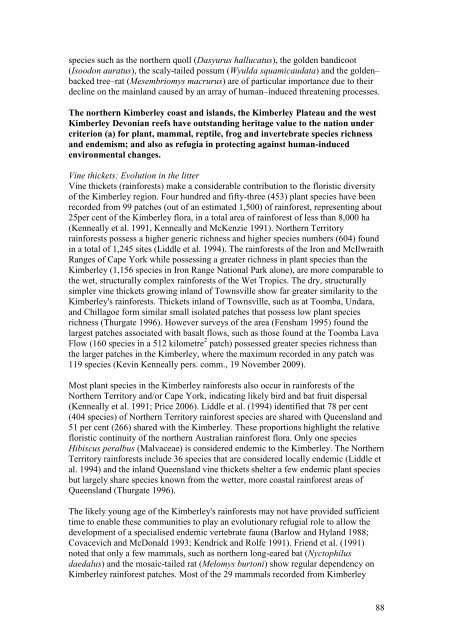WEST KIMBERLEY PLACE REPORT - Department of Sustainability ...
WEST KIMBERLEY PLACE REPORT - Department of Sustainability ...
WEST KIMBERLEY PLACE REPORT - Department of Sustainability ...
Create successful ePaper yourself
Turn your PDF publications into a flip-book with our unique Google optimized e-Paper software.
species such as the northern quoll (Dasyurus hallucatus), the golden bandicoot<br />
(Isoodon auratus), the scaly-tailed possum (Wyulda squamicaudata) and the golden–<br />
backed tree–rat (Mesembriomys macrurus) are <strong>of</strong> particular importance due to their<br />
decline on the mainland caused by an array <strong>of</strong> human–induced threatening processes.<br />
The northern Kimberley coast and islands, the Kimberley Plateau and the west<br />
Kimberley Devonian reefs have outstanding heritage value to the nation under<br />
criterion (a) for plant, mammal, reptile, frog and invertebrate species richness<br />
and endemism; and also as refugia in protecting against human-induced<br />
environmental changes.<br />
Vine thickets: Evolution in the litter<br />
Vine thickets (rainforests) make a considerable contribution to the floristic diversity<br />
<strong>of</strong> the Kimberley region. Four hundred and fifty-three (453) plant species have been<br />
recorded from 99 patches (out <strong>of</strong> an estimated 1,500) <strong>of</strong> rainforest, representing about<br />
25per cent <strong>of</strong> the Kimberley flora, in a total area <strong>of</strong> rainforest <strong>of</strong> less than 8,000 ha<br />
(Kenneally et al. 1991, Kenneally and McKenzie 1991). Northern Territory<br />
rainforests possess a higher generic richness and higher species numbers (604) found<br />
in a total <strong>of</strong> 1,245 sites (Liddle et al. 1994). The rainforests <strong>of</strong> the Iron and McIlwraith<br />
Ranges <strong>of</strong> Cape York while possessing a greater richness in plant species than the<br />
Kimberley (1,156 species in Iron Range National Park alone), are more comparable to<br />
the wet, structurally complex rainforests <strong>of</strong> the Wet Tropics. The dry, structurally<br />
simpler vine thickets growing inland <strong>of</strong> Townsville show far greater similarity to the<br />
Kimberley's rainforests. Thickets inland <strong>of</strong> Townsville, such as at Toomba, Undara,<br />
and Chillagoe form similar small isolated patches that possess low plant species<br />
richness (Thurgate 1996). However surveys <strong>of</strong> the area (Fensham 1995) found the<br />
largest patches associated with basalt flows, such as those found at the Toomba Lava<br />
Flow (160 species in a 512 kilometre 2 patch) possessed greater species richness than<br />
the larger patches in the Kimberley, where the maximum recorded in any patch was<br />
119 species (Kevin Kenneally pers. comm., 19 November 2009).<br />
Most plant species in the Kimberley rainforests also occur in rainforests <strong>of</strong> the<br />
Northern Territory and/or Cape York, indicating likely bird and bat fruit dispersal<br />
(Kenneally et al. 1991; Price 2006). Liddle et al. (1994) identified that 78 per cent<br />
(404 species) <strong>of</strong> Northern Territory rainforest species are shared with Queensland and<br />
51 per cent (266) shared with the Kimberley. These proportions highlight the relative<br />
floristic continuity <strong>of</strong> the northern Australian rainforest flora. Only one species<br />
Hibiscus peralbus (Malvaceae) is considered endemic to the Kimberley. The Northern<br />
Territory rainforests include 36 species that are considered locally endemic (Liddle et<br />
al. 1994) and the inland Queensland vine thickets shelter a few endemic plant species<br />
but largely share species known from the wetter, more coastal rainforest areas <strong>of</strong><br />
Queensland (Thurgate 1996).<br />
The likely young age <strong>of</strong> the Kimberley's rainforests may not have provided sufficient<br />
time to enable these communities to play an evolutionary refugial role to allow the<br />
development <strong>of</strong> a specialised endemic vertebrate fauna (Barlow and Hyland 1988;<br />
Covacevich and McDonald 1993; Kendrick and Rolfe 1991). Friend et al. (1991)<br />
noted that only a few mammals, such as northern long-eared bat (Nyctophilus<br />
daedalus) and the mosaic-tailed rat (Melomys burtoni) show regular dependency on<br />
Kimberley rainforest patches. Most <strong>of</strong> the 29 mammals recorded from Kimberley<br />
88
















